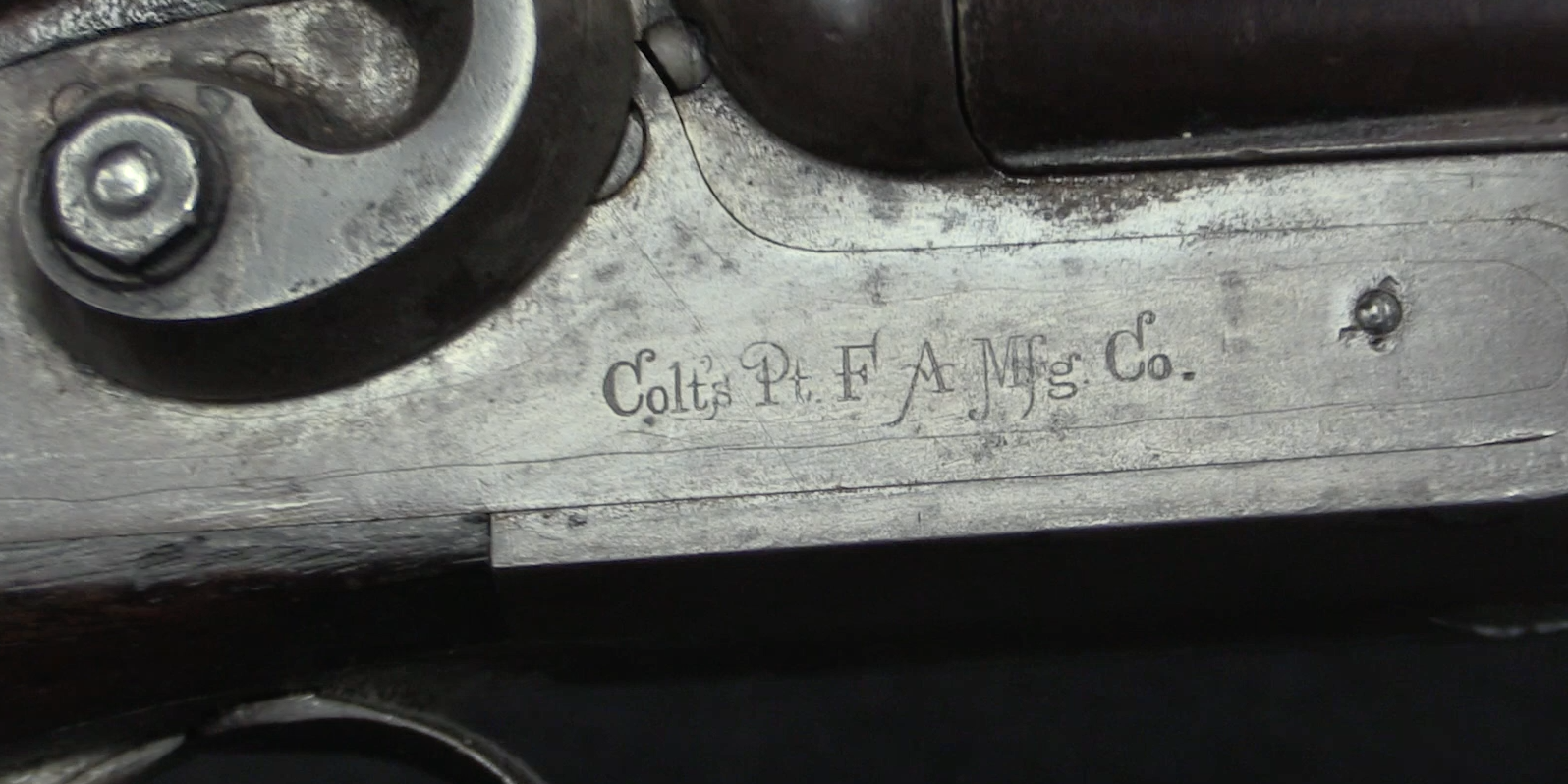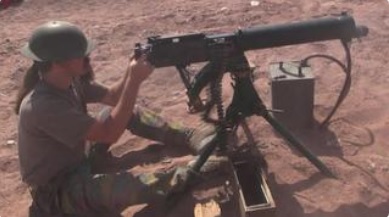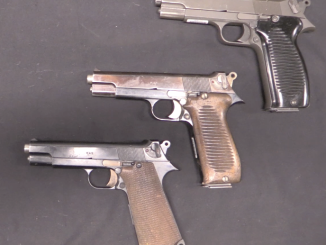This Hotchkiss and its accessories are lot #1116 at Morphy’s April 2019 auction:
Benjamin Hotchkiss was an American artillery designer who moved to Paris in 1867 in hopes of building a business for his improvements in artillery shells. He experienced the Franco-Prussian War in 1870, and understood the failure of the French Mitrailleuse multi-barrel volley guns. In his opinion, an effective rapid-fire weapon needed to fire explosive projectiles to have a real effect at extended range (unlike the mitrailleuse which fired simple rifle bullets). So being the inventive sort, he went ahead and designed just such a gun. His revolving cannon was sized for 1-pound (450g) 37mm explosive shells (although he would also produce armor piercing and canister ammunition). The gun looks like a Gatling gun at first glance, but its mechanical operation is quite different.
The Hotchkiss cannon would become quite popular, with major purchases by the French and American navies as well as many other nations. They would serve into World War One, including some use repurposed as antiaircraft weapons. This particular example was captured by American forces in Cuba during the Spanish-American War, most likely from San Juan Hill. It is a magnificent example of the type, and with a fantastic historical provenance to match.




The Spanish ejército ultramar in Cuba surrendered Santiago de Cuba to the U.S. Army Vth Corps. The Hotchkiss gun may have been among the forts that ringed the city, or, for that matter, el Caney as well as San Juan and/or Kettle Hills.
The gun was lavishly used to defend the huge ditches/fosées of French forts, including those at Verdun, as Ian stated. This French website shows the guns in such forts, in 37mm, 47mm, and 53mm as well as a German WWI film from the Bundesarkiv of soldaten bemusedly rotating the barrels:
http://www.fortiffsere.fr/artillerie/index_fichiers/Page910.htm
There was a special fort defence version in 40 mm calibre, which fired canister shot to clear the ditches at short range. Some of these were apparently still in service at the beginning of WW2!
“(…)450g(…) 37mm explosive shells(…)”
Possibly primal reason for choice of this size was Declaration Renouncing the Use, in Time of War, of Explosive Projectiles Under 400 Grammes Weight from 1868
https://en.wikipedia.org/wiki/Saint_Petersburg_Declaration_of_1868
Name is pretty explanatory, however it must be noted that Declaration… was active only during war between its signatories.
“(…)Hotchkiss cannon would become quite popular(…)purchases by(…)other nations(…)”
According to http://navweaps.com/Weapons/WNRussian_37mm_Hotchkiss.php Russians both bought and produced it (in Tula).
“(…)looks like a Gatling gun at first glance, but its mechanical operation is quite different(…)”
How does it works 3D animation: https://www.youtube.com/watch?v=GkOP8Lwdmgg&feature=youtu.be
By all accounts, the main reason for the St. Petersburg Declaration was the use of explosive bullets in rifle-muskets by both sides in the American Civil War.
Although the reason 37mm and 400gm mass was chosen as the minimum had less to do with that than it did with the fact that at the time, the technology did not allow for an impact-fuzed explosive shell much less than that size to still have a worthwhile charge. The limiting factor being the minimum dimensions of a practical impact fuze that was safe to fire, i.e., one with a safety system that only unlocked once it left the muzzle, preventing bore prematures.
By WW1, of course, the technology had matured to allow practical explosive armor-piercing projectiles down to 20mm diameter. Ironically, this wasn’t much larger in caliber than some of the shoulder arms used only four decades earlier (.79 caliber vs. .58 to .75 or so).
cheers
eon
The St Petersburg Declaration was only concerned with shell weight, not calibre; 37 mm just happened to be the right calibre for a 400 g shell at that time. This limitation was broken in WW1 by the use of incendiary and HE bullets against hydrogen-filled observation balloons and airships, and after the war it was tacitly agreed that the 400 g limit could be ignored in the case of aircraft and anti-aircraft weapons. I suspect that the last design to see service which respected the limitation was the USN 1.1 inch AA gun system developed in the 1930s, as the shell weight was 416 g.
For a lovely animation of one of the naval mounted guns of which Ian speaks, and further details of the mechanism he demonstrated from behind the breech end, see here:
https://www.youtube.com/watch?v=GkOP8Lwdmgg&list=PLnpCT67IkeGcDBR0aNPqHTwaP-hvuq3W4&index=5&t=0s
Regards,
Dave
The ancestor of many a warship’s close-in-weapons-system! I’m just kidding, but the eventual use of this gun as flak seems appropriate, as rifle bullets won’t do much damage to planes unless they hit vital spots (including the pilot’s posterior region).
“ancestor of many a warship’s close-in-weapons-system! I’m just kidding”
Actually not. In fact one of tasks of 37 mm 5-barrel gun was to destroy enemy vessels attempting to launch torpedoes – which was possible with limited range of early torpedoes.
However with introduction of torpedoes with greater range like
https://en.wikipedia.org/wiki/Whitehead_torpedo
as well faster small vessels able to deploy torpedoes and bigger torpedo launching vessels, this gun become insufficient for its destined purpose. In case of Russian Empire this was showed blatantly by experiences of Russo-Japanese war (1904…1905) and soon most of these guns were relegated to other duties.
Well, the installation of rapid-fire weapons on ships for use against torpedo/gun boats, missiles, and low-flying attack aircraft is still valid. I’d also have to mention suicide boats, which you can’t really track with a heavy cruiser’s main guns. Did I mess up?
Cherndog: If you read “The Battle of the Narrow Seas” by Peter Scott (he of the Antarctic Treaty, the book is available as an E-book at moderate cost) you will see that even in WWII, torpedo and gun engagements were still taking place at 300 yards or occasionally less. Especially when the target was a smaller ship. The torpedoes of the day were not “minute of angle” weapons! The 37mm revolving cannon was outdated by that time, of course, but the 2-pounder Rolls gun was in use (about the same bore diameter), along with 20mm cannon, 0.5″ machine guns and 3″ QF guns.
When it appeared, though, the 6-pounder Molins Gun was the star for this sort of thing.
https://en.wikipedia.org/wiki/Ordnance_QF_6-pounder#Molins_gun
This did have a longer effective range, though it took a hydraulic platform to make this usable at long range in rough seas from a D class boat. The North Sea really can’t be relied on to be calm!
So, the same sort of concept as the Hotchkiss revolving gun, but an automated QF gun rather than a dumb “automatic” gun. The thing was, 37mm and 40mm shell did not usually sink things like E-boats, unless many hits were scored. A 6 pounder (57mm) shell was about the minimum size which did the job. There were actually “automatic” 6 pounder and even 3″ guns for bigger ships and harbour defence batteries, but those things were a lot bigger and heavier than a Molins and really represented a cruder technology. The 3″ was only really worth fitting to the Blake Class cruisers. The 6 pounder harbour defence guns did not fire the same cartridge as the Molins because they were designed years before the parent 6 pounder QF anti-tank gun.
Given how WWI aircraft were constructed, and how close they had to come to do any damage with the weapons that they had (20lb bombs for instance), the buckshot cartridges might actually have been better for point air-defence than the explosive shells, unless the latter had a really sensitive fuse and a REALLY trustworthy self-destruct mechanism. As the French Army determined when testing the 13.2mm Hotchkiss heavy machine gun in the nineteen thirties: what goes up, comes down.
Certainly in WWII, Royal Navy steam gunboats used 3″ buckshot cartridges against German aircraft, sometimes successfully, because the incoming bombers were all effectively aiming THEMSELVES at a predictable point in space not far above the gunboat’s bridge -and because of the gunboat’s small size and high speed, the bombers had practically no chance of doing any damage if they made a different approach -at which point, you didn’t really mind not being able to hit them. You would not have wanted an explosive shell to explode a hundred feet or so above your own open bridge. Ten 37mm buckshot cartridges might have done the work of one 3″ one. I can see a 37mm HE shell going right through an early biplane without exploding, though.
“trustworthy self-destruct mechanism.”
Actually in terms of 1910s technology, it is much easier for 37 mm rather than 13,2 mm shell.
According to http://wiki.wargaming.net/ru/Navy:37-%D0%BC%D0%BC_%D1%80%D0%B5%D0%B2%D0%BE%D0%BB%D1%8C%D0%B2%D0%B5%D1%80%D0%BD%D0%BE%D0%B5_%D0%BE%D1%80%D1%83%D0%B4%D0%B8%D0%B5_Hotchkiss during Great War, in Russian Empire for AA work shells with self-destruct = 8 seconds were used.
CAUTION: side effects of operating this cannon may include a sudden compulsion to liberate Cuba and annex the Philippines.
http://wiki.wargaming.net/ru/Navy:37-%D0%BC%D0%BC_%D1%80%D0%B5%D0%B2%D0%BE%D0%BB%D1%8C%D0%B2%D0%B5%D1%80%D0%BD%D0%BE%D0%B5_%D0%BE%D1%80%D1%83%D0%B4%D0%B8%D0%B5_Hotchkiss reports that 37 mm Hotchkiss 5-barrel gun in field gun variant is stored in Fields of Thunder Museum (California).
I wonder why this is “unlisted” at YouTube. I guess I can’t watch it on my Roku.
The Tenth Cavalry took San Juan Hill.
The Rough Riders were their white auxiliaries.
The Big Stick’s Rough Riders use a rock-beats-laser tactic against the Spanish.
The use of pneumatic artillery and plain-old ambush tactics comes to mind.
That’s the Ninth Cavalry. Both regiments went up the hill, the Ninth had been waiting for orders when Roosevelt led the ‘Rough Riders’ into the attack.
Ord, with “D” of the Tenth, charged and everyone else followed. The 10th’s buffalo soldiers, and then the 9th’s, were running up San Juan hill while the Rough Riders were still drinking coffee.
144 Americans were killed at San Juan Hill. 26 were from the 9th and 10th Residents. Teddy Roosevelt later said the buffalo soldiers would only advance as far as their white officers led them. This may or may not be true. Still the proportion of casualties is…call it interesting
Interesting the Hotchkiss. I can think of three of these guns out in the wild. Two are in front of a municipal building on Route 12 in Michigan, and one sits on a pedestal guarding a cemetery in rural upstate NY.
A magnificent design and execution. Truly, they don’t make them like they used to.
Does the camming surface that fully seats the cartridge in the breach also act to hold the cartridge in the breach when it fires, and how is the spent case extracted?
Take a look at animation; it is not super-clear, but hopefully it helps.
The technology used for this time period is simply stunning, be it from mechanical engineering or manufacturing standpoint. Very advanced indeed.
I bet this gun will make an impressive piece in entry hall of some plush villa/ hacienda 🙂
I would love to see the documentation that this was captured from the Spanish. All the primary documents I have seen indicate that the Spanish field ordinance was mostly new quick-fire guns and the Hotchkiss Revolving Cannons (HRC) field guns used in the war were all American (most deployed with smaller Gatling guns in “Gatling Batteries”). The Spanish did have HRC guns on the Navy ships in the harbor and it could have been salvaged from one of them and put on a field carriage by the US Army.
The build plate indicates Hotchkiss Paris factory as the origins and the text is that used for export to English speaking nations. However that is not definitive given the nature of arms sales in the 19th century.
Does anyone have access to Hotchkiss Factory records and can look up the sale of Gun number 1198?
San Juan Hill or looking for Teddy Roosevelt’s epics . Undoubtably he was a man of merit but also a great self-promoter who in his memoirs capitalized the victory of San Juan Hill battle, exaggerating also the capability of Spanish defenders in his profit. We can read in his book «and some of the men cried, “The Spanish machine-guns!”», but also that «It’s the Gatlings, men, our Gatlings!”», that is the American Gatling machine gun detachment that decided the battle. So, in Santiago de Cuba land battle participated Lieutenant Parker detachment’s four .30-40 Gatling machine-guns (his book, “History of the Gatling gun detachment, fifth army corps. Santiago”, was available in digital edition), but THERE WASN’T SPANISH MACHINE GUNS. Spanish firepower came from the deadly fire of Spanish Mauser rifles, supported by two excellent Krupp M1895 75 mm mountain guns.
So, was really Morphy Auctions`s Hotchkiss revolving cannon captured in Santiago de Cuba? YES, PROBABLY IT WAS. But, which is its origin? A brief comment:
I don’t know what was in Benjamin Hotchkiss mind when he designed this gun, land or naval warfare, but his 37mm revolver gun was used world way as naval gun, that was mounted in big vessels to fight the new torpedo boats, but sometimes was mounted in land fortresses. In Spain it was used only as a naval gun.
Referring to Cuba, Santiago had no coast defenses at the beginning of Spanish-American war (so only Admiral Cervera´s foolish behavior can explain that Spanish Navy`s Atlantic Squadron was bottled there). In Santiago port there was an old iron hulled cruiser, the Reina Mercedes, and part of his artillery was used for the improvised coast defenses urgently build in Santiago bay. The chief guns were Reina Mercedes’ Gonzalez-Hontoria 16 cm -6.3 in- guns, but also were landed four Hotchkiss 37mm revolving cannons for the protection of the torpedo (mine) lines emplaced to cut the entrance of the bay. All these Navy`s guns (with some others) were manned by Navy`s personnel. Naval Hotchkiss were never mounted in wheeled carriages, so I suppose that this carriage is not the original one but probably installed in a later date for use by U.S. Army.
Summarizing, this is a Spanish naval cannon captured from Santiago coast defenses and probably mounted in a wheeled carriage in the United States.
How did it eject spent shells?
How did the firing pin hit the shell when it was at 5 o’clock and the shell was at 11?
It fires always in the same position. Here in this video you can see it:
https://youtu.be/GkOP8Lwdmgg
In this image you can see the Spanish Navy Hotchkiss 37 mm revolving cannon, above on a Spanish cruiser (1892) and bellow in the Socapa battery, in Santiago de Cuba (this may be the cannon of this video).
[img]https://i.imgur.com/rc8IVmo.jpg[/img]
https://i.imgur.com/rc8IVmo.jpg
Willie Arrants: well said -and Merry Christmas!